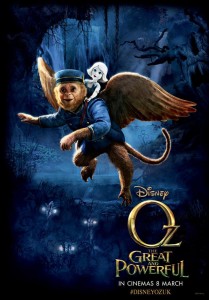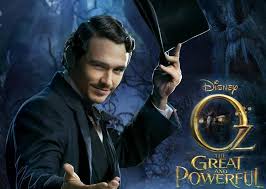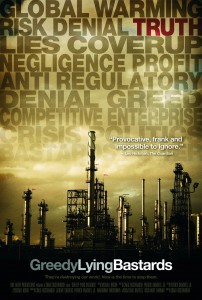 A prequel to one of the most beloved films of all time is a daunting challenge, but Disney’s prequel to “The Wizard of Oz” manages to balance respect for the original with some fresh and appealing insights into the story. But the real star of the story is the enchanting, rapturously imagined setting, brilliantly designed by Bob Murawski and directed by Sam Raimi. From the captivating opening credit puppet theater, we are immediately in the world of magic and mystery — and hokum.
A prequel to one of the most beloved films of all time is a daunting challenge, but Disney’s prequel to “The Wizard of Oz” manages to balance respect for the original with some fresh and appealing insights into the story. But the real star of the story is the enchanting, rapturously imagined setting, brilliantly designed by Bob Murawski and directed by Sam Raimi. From the captivating opening credit puppet theater, we are immediately in the world of magic and mystery — and hokum.
Like the 1939 Judy Garland classic, the movie opens in black-and-white. The screen is shrunken to the proportions of the 1930’s. And, like the Garland version (but not the books), the characters and themes of Oz are echoed in the scenes set back home. Oscar Zoroaster Phadrig Isaac Norman Henkel Emmannuel Ambroise Diggs, known as Oz for his first two initials, is a showman and a con man, a magician in a small traveling circus. Personally and professionally, his life is about fooling as many people as possible. He is constantly either trying to impress a pretty girl or trying to avoid any personal entanglements, romantic or friendship.
It is telling that his big trick is to select a pre-arranged “country girl” from the audience apparently at random, making her seem to float in the air, and then wait for the viewers to think they’ve figured out the trick by noticing the wires that appear to keep her suspended. This makes possible the dramatic flourish — he cuts the wires to reveal that he has not just made her float — he has made her disappear. Oz is eternally poised on the brink between reality and illusion, between connection and distance, between appearing (no one is more visible than those whose profession is to perform in public) and disappearing (he always seems to have a means of escape handy). At the same time, the “country girl” is discovering that he lied to her, the circus strong man is coming after him for flirting with his wife, and he receives a visit from the only woman we sense he has ever really cared for (Michelle Williams), who asks him if there is any reason she should turn down a proposal from another man. He tells her to accept, though it is clear that he has some regrets. And then, he does what he does best — he escapes, jumping into the circus hot air balloon, which is whipped into a twister, and which deposits him in a strange and wondrous land of lush and vivid color — Oz.
 The first creatures he meets are nasty little water fairies with big teeth and a stunningly beautiful woman with a splendid brimmed hat named Theodora (Mila Kunis). She seems to think that he is the wizard from a prophecy — a man with the same name as their enchanted land, who would arrive to rule as king and free their people. Freeing the people does not have much appeal for Oz, but he is definitely intrigued by the notion of a palace, a throne, and a scepter. “Is the scepter made of gold?” he asks, to make sure that this deal is as sweet as it sounds.
The first creatures he meets are nasty little water fairies with big teeth and a stunningly beautiful woman with a splendid brimmed hat named Theodora (Mila Kunis). She seems to think that he is the wizard from a prophecy — a man with the same name as their enchanted land, who would arrive to rule as king and free their people. Freeing the people does not have much appeal for Oz, but he is definitely intrigued by the notion of a palace, a throne, and a scepter. “Is the scepter made of gold?” he asks, to make sure that this deal is as sweet as it sounds.
We know that Oz will be come the wizard and live in the palace. We know he will become “a good man but a bad wizard,” hiding behind the curtain as he works the controls of a huge face with a booming voice. We know he will bestow gifts that show people the greatness that is already within them. And we know he will have to take a journey to get there. Writers Mitchell Kapner and Pulitzer Prize awardee David Lindsay-Abaire (“Rabbit Hole“) weave in characters and themes inspired by some of the other Oz books as well, including a girl made out of porcelain, rescued from her shattered “China Town.” Oz meets up with two other witches as well, including one who has a very bad reaction to moisture. And he is not the only one who has to decide which side he will be on.
The visuals are fabulously imaginative, consistently surprising and new and yet consistent with our ideas about Oz from the books and the 1939 film. That’s consistent but not identical — Disney had to be careful not to get too close to MGM’s copyrighted designs. So there are flying monkeys, but very different (and even scarier), a poppy field, and an Emerald City gatekeeper (who will be familiar to fans of Sam Raimi’s less family-friendly films). The 3d effects are effective, especially during the twister. Franco’s characterization wavers at times and he never quite persuades us that he is at heart a showman. The big reveal about what prompts a witch to turn evil is disappointingly under-imagined. Indeed, for a movie with three significant female characters played by three of Hollywood’s most talented women and the China Girl (voiced by Joey King), the film’s conception of women is unfortunately superficial, simplistic, and male-oriented. It is an enchanting journey — but at the end you may wish to click your heels three times to return to the peerless Garland version and the books. There’s no place like home.
Parents should know that this film includes extended fantasy peril, action, and violence, with scenes of devastation and loss, jump out at you surprises, and scary monsters, some disturbing images, brief mild language, a character who makes advances at many women, and scenes of jealousy, anger, and sadness.
Family discussion: What is the difference between being a great and a good person? Why did Glinda believe in Oz? How did the characters in the prologue relate to their counterparts in Oz? What elements of the classic Oz story are explained in this film?
If you like this, try: the Oz books by L. Frank Baum, and the classic film with Judy Garland



